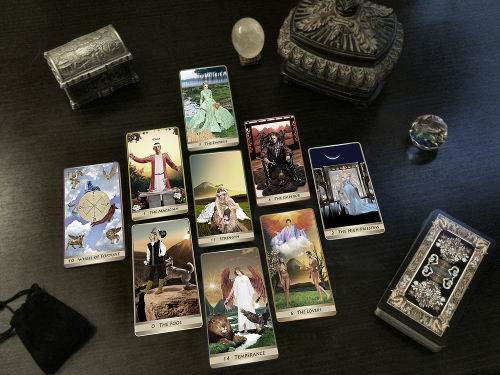Lesson 10: Spreads Part I

Now that you've studied the whole deck of 78 cards and practised with the basic 3 card spread, we'll move on to a couple of other spreads for you to work with.
You may have found that some cards have stuck in your mind and have a special significance for you, others may still be hard to remember, so if you still need to use your Tarot books and your notes that's fine.
So take out your deck and let's begin. You'll soon be having fun reading
more detailed spreads for yourself and others.
It isn't always necessary to use all 78 cards when you do a Tarot reading. There are many ways to use the cards.
for example you could use ...
- the Major Arcana
- the Minor Arcana
- Aces and Major Arcana
- Aces and Minor Arcana
- Court cards and Minor Arcana
- Court cards and Major Arcana
If you do a little research by studying different Tarot books and other web sites, you'll discover hundreds, if not thousands of different spreads and card combinations - you can even create your own mix of cards and your own spreads!
In lesson 12, I'll be covering guidelines for reading the Tarot in a little more detail, but for now I'll simply outline a couple of basic pointers to help you get started.
Card Positions and Orientation:
Some people read the cards differently, depending on whether they are reversed (upside down) or upright. This is a personal preference and one you need to decide for yourself. Personally, I choose to get a feel from the spread as a whole, to guide me as to whether a card is indicating its negative or positive interpretation, and I ignore whether a card is reversed or not.
You can do the same, but if you find that difficult, you can read upright cards as positive in meaning and upside down (reversed) cards, as negative in meaning.
Intepreting the relationship between cards in their various positions is a little more difficult. Many books do give some guidance on this, and I recommend Jonathan Dee's excellent 'Tarot an illustrated guide' for this reason.
For now, simply understanding what each card indicates in a particular position in a spread will enable you to give a reasonable reading
The Client:
When you read for someone, this person can be referred to as 'The Querant' or 'The Enquirer' and they should shuffle the cards.
When they have finished shuffling you can spread the whole deck and ask them to pick the appropriate number of cards, or you could split the deck into 3 smaller packs and get them to pick a pack they are most drawn to. I choose to do the latter, but you can feel free to find your own way for the querant to pick their cards.
Many people feel quite nervous when they come for a reading, especially for the first time, or if they are feepng distressed about something. Find your own way to make them feel at ease.
I do this by explaining the process and what I believe the tarot is all about. I explain each of the spreads I use and often explain the meanings of the cards. However, many Tarot readers feel it is better not to do this, and only convey the message they see in the cards. It's up to you to find your own way of working with the tarot and with the people you read for.
